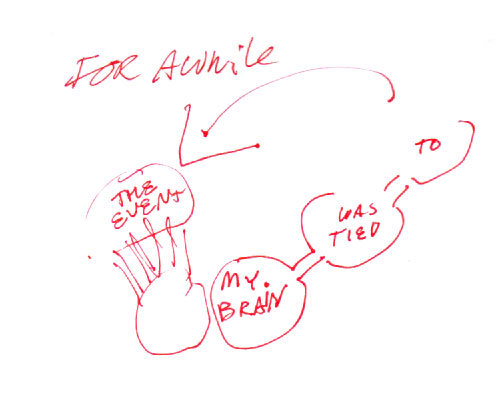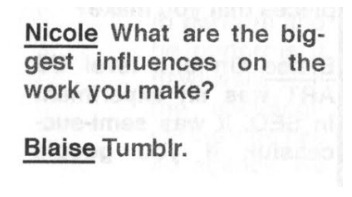#blaise larmee
Photo
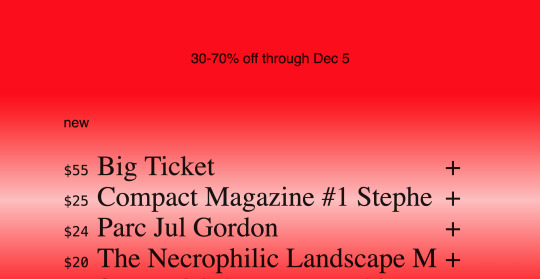


new site
new books
new newsletter (drawing by angela fanche)
+ a 30-70% OFF sale. last 2 days...
stephen can you re-tumbl?
#2dcloud#big ticket#compact magazine#the necrophilic landscape#parc#frozengirl#stephen z hayes#morgan vogel#jul gordon#iku kawaguchi#raighne#yvan algabé#sarah cuje#brian bamps#liza kotlar#ellen plant#ash hg#samuel r delany#blaise larmee#katherine dee#altcomics#clair gunther#angela fanche#maggie umber#caveh zahedi#lale westvind#tara booth#paul peng#josiah parker#jason overby
58 notes
·
View notes
Text

www.2dcloud.com
🎫
Type: Publisher / Bookseller. Direct Sales.
Available: Subscription to New Books
Catalogue of 60 titles
#Blaise Larmee#Katherine Dee#defaultfriend#Samuel R Delany#Raighne#Stephen Z Hayes#Ellen Plant#Sarah Cuje#Morgan Vogel#Ash HG#Jul Gordon#Iku Kawaguchi#Yvan Alagbe#2dcloud#Brian Bamps#Liza Kotlar#Maggie Umber#Caveh Zahedi#Paul Peng#Josiah Parker#Steve Grove#Clair Gunther#Tara Booth#Lale Westvind
9 notes
·
View notes
Text
about the “Altcomics” tumblr
Hey comics friends, I’ve been seeing the Altcomics tumblr being reblogged a lot lately, and I understand why! It’s got a great collection of independent comics on the artistic/poetic side of things. But people may not know that altcomics is run by Blaise Larmee, who was fired from his position as creative editor at 2dcloud publishing for “predatory behavior” in January, 2018.
There's not much more information out there, but 2dcloud felt this was serious enough to actually pulp his most recent book 3 Books and to even discontinue their original zine/event series Altcomics on top of firing him! They made two statements on their twitter on Jan 21st, 2018, and also published a longer public statement on Medium on Jan 14th that has now been deleted, but can be read via the Wayback Machine. Here’s some relevant quotes:
(1) We regret publishing 3 Books. We take responsibility for publishing it and thus hurting survivors. Although we did not know what we know now, we acknowledge that we should have known better and researched more thoroughly prior to publication.
(2) Survivors want complete privacy. More on this subject would be inappropriate to share. Please respect their wishes and do not make inquiries.
(3) We pulped and pulled all of our copies of 3 Books from our inventory and no longer offer it for sale on our site.
(4) 2dcloud is cutting ties with Blaise Larmee. Blaise Larmee was in charge of 2dcloud’s website, visual designs, and Altcomics magazine. We are working on the new website; we discontinued using “Altcomics” name for our zines and our event series.
This is not to say you are a monster if you keep following him or whatever. But this is something I personally would want to know! And I want to get the information out there so everyone has a fair chance of avoiding (yet another) predatory person in comics and ensuring that there are no other people harmed by his actions.
#alternative comics#altcomics#2dcloud#blaise larmee#independent comics#l3 host post#comics by others
34 notes
·
View notes
Photo

From Yoko Ono in “Hot Day” by Blaise Larmee
41 notes
·
View notes
Photo
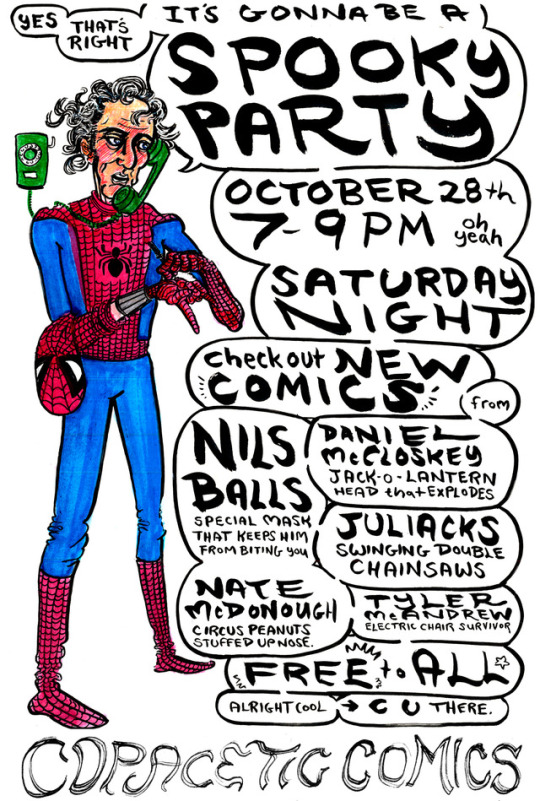


SPOOKY PARTY
THIS Saturday, October 28, from 7:00 to 9:00pm, SPOOKY PARTY returns to Copacetic HQ on the 3rd floor at 3138 Dobson Street in Polish Hill (15219). On hand this year are: CMU alum, and globetrotting multidisciplinary artist, Juliacks, who is coming through town to celebrate the release of her category-defying work, The Architecture of an Atom (above right), just released by 2dCloud; erstwhile Pittsburgh-resident, Blaise Larmee, who will likewise be premiering his new book, 2001(above left), also from 2dCloud; the indefatigable Nate McDonough, who will – naturellement! – be premiering a new comics work (and who is responsible for the event flier above); Dan McCloskey, who has returned to home base after a year of nearly non-stop traveling and adventure, just in time to finish up a short piece of comics that will premiere here; Nils Balls, who is, as we type, burning the midnight oil to get his latest project ready for the Spooky Party deadline; and… who knows who else might have a new comic to premiere? Be prepared!
15 notes
·
View notes
Text
Apartment.Gallery
That gap between the door and the floor, a crack where crushed sun leaks in. This is what I see before entering Apartment Gallery. All I really remember about the stairwell is the muddy dark brown wood of everything, cut by hiatuses of off-white walls.
It’s an apartment but there isn’t any furniture. There are the paintings, and barely anything else to take in besides them. Two rooms with pictures: the living room and a small bedroom to the left of the kitchen. And in the kitchen there’s an orange slice keychain on a countertop. People huddle in two’s and three’s, their bodies become one big eye, with their heads the iris and turning peripherally. Then at the end of the night, everyone is crosseyed and bowlegged. Always one eye on the painting, the other on your interlocutor.
The show. Two painters unite. Kevin Larmee and Vogel Morra, hung and organized by Blaise — Kevin’s son, the cartoonist — in Chicago’s upper Northside. Kevin Larmee paints people, docks, water, sunless sky (the Beginning) and moonless sky (the End). And Morra paints people, flowers, vases, windows, fireplaces, chairs, and trees. Larmee and Morra’s paintings are joined by the grace and awkwardness needed to dance. Larmee favors blues and blacks, bruising the canvas as a necessary arrow of love. Morra: purples and pinks.
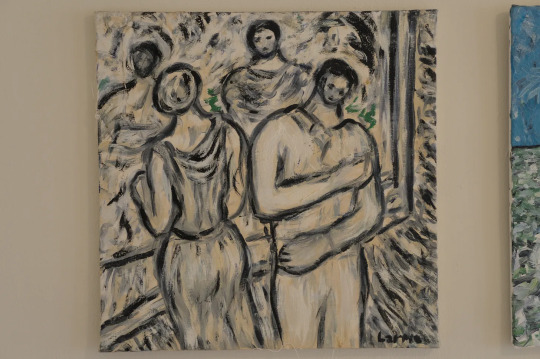

The opening is like this: a dotted line tracing a butterfly’s ditz through the sky.
by Brianna Perry @precious-silly-thing
for House on Fire (2dcloud)
It’s mostly Blaise’s friends here. They seep through the doorway, many of them seem to be meeting for the first time. Someone asks me what I do and I say I am an artist. It feels less embarrassing to say that here. I ask someone, ‘Are you a painter?’ A mawkish ‘kind of’ comes out of her mouth. Some of them are grad students at the University of Chicago, members of a Javanese gamelan ensemble. Spotted: Ash H.G., a cartoonist with a forthcoming graphic novel called East District. And Katherine Dee, the writer and internet anthropologist. The show’s artists are missing. “They’re both mysterious, so — “ trails off Blaise.
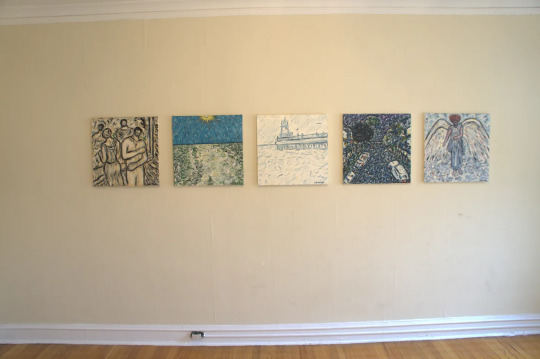
Paintings are the alignment of constellations, the flipping of a lucky cigarette into the first spot in a pack, stubby toes on crushed velvet. The fracture is fifty words for snow. Dipping a brush in dreamless water, shaping its hair into a fine cone. A brush’s bristles can be tweezed easily from hogs, sables, minks, mongooses, horses, ponies, wolves, sheep, rabbits, goats, camels, and oxen. The bristles are bred for this, a descending column of Kundalini blockages. A brush is vestigial. We can paint with slices of clementine if we weather the juice.

Larmee’s pictures are cosmic in subject matter but not in scale. There is a tiny importance to them, like a single petal or a Beanie Baby. When I said Larmee painted people, I include angels in this category. A redheaded angel appears opposite his depiction of two figures in silhouette, where one is leading the other through a building being destroyed in a fire.
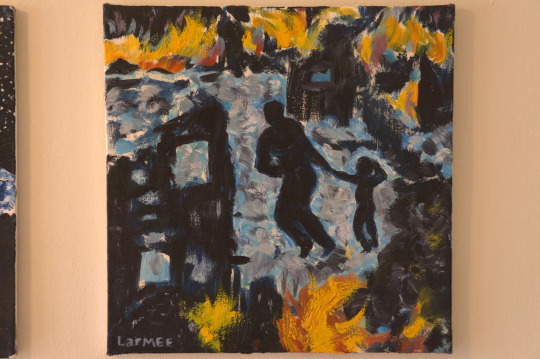
Morra’s paintings are predominated by portraiture. The figures are nearly expressionless and anhedonic. It becomes increasingly important to the viewer to determine if the scene painted is candid or posed. Argument for candid: the space surrounding the figures is inchoate, tohu-bohu Rastafari. Argument for posed: Everyone who poses for Morra instantly become an image. Morra’s people scrape by with very little definition: a dot that’s an eye, a line that’s a mustache. The figures are saved from facelessness. It’s not anonymity, it’s privacy.

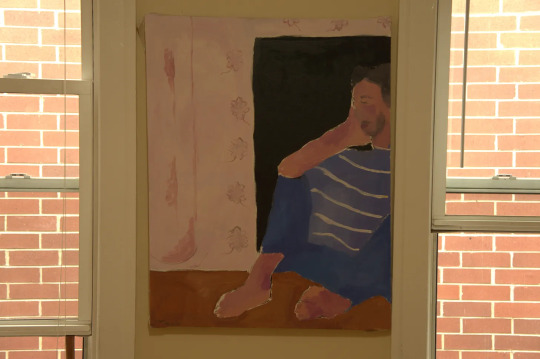
There’s mackerel, rice, beer, an idiom of wine whose name I can’t recall. Stephen tells me the name of the wine and I ask ‘Is that a director?’
The sun’s setting, each ray in danger of falling off the central axis. Larmee’s paintings illuminated in ring-like formations, the sun contouring each painting like melted popsicle circumscribing a mouth. The paintings are all surface: there is no pretense given to stain. It’s a painting. The application of paint is thick, white light is pressed and squeezed out between figures or waves.
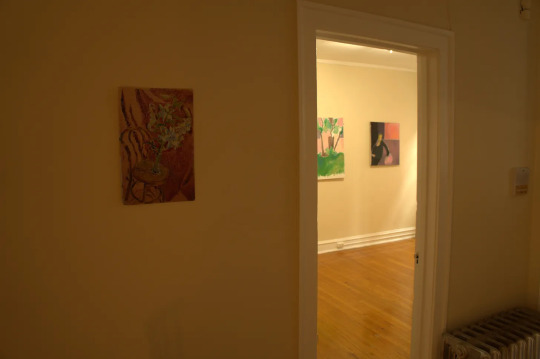
Morra lets more light in. There are passages of color above solid blocks of pigment. The subjects of Morra’s paintings are alone. This painter favors the margin. Men sit in corners or against walls, ever brooding. Only the trees feel collective— as faceless, inconspicuous, upright weather vanes. The brushstrokes staccato across the picture plane, each tree having its own auric shield. A tree in the foreground, cooped in pinks. Morra’s paintings are all wall, retaining walls to be specific.

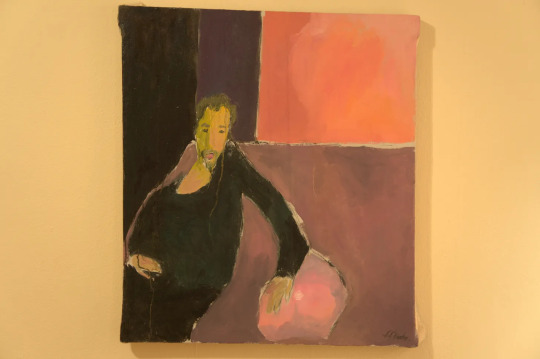
Rock-em sock-em puddles of grass indiscriminately line the bottom of Morra’s painting of trees. This is a terpene-lined pastoral. In the living room, Larmee’s dorky grisaille and oceanic ground respond in kind. The dharma of every picture is that each brushstroke precipitates on the surface of the canvas, foggy warm breath making opaque condensation drawings on the pane of the viewer’s mind.


People fall in and out of the apartment.
And there’s a declining population by 6:30. Conversation has given way to current events. I feel good, because I have talked to everyone there an adequate amount.
One last note: Larmee’s paintings are business-casual, Morra’s are a loosened necktie after a long day at the office. Morra’s paintings struggle to unmoor themselves, the untucked canvas looping around the picture plane like ice cream birthday cake frosting.
The opening’s over. Stragglers sit crosslegged on the floor or perch on the window sill. The sky is purple and blue allover, high noon finally celebrating its quinceañera. It’s getting late, people return to their lives. All we have left is a painting between us, a sick twisted jeremiad dedicated to autumn.

Apartment Gallery is an apartment and gallery on Chicago’s north side. Vogel Morra and Kevin Larmee ran from September 30th to October 23rd, 2023.
22 notes
·
View notes
Photo

2001, Blaise Larmee’s enigmatic deconstruction of the graphic novel
35 notes
·
View notes
Text
DOGNURSE by Margot Ferrick
Margot Ferrick’s new comic, printed by Perfectly Acceptable Press, has an obvious difference with her book Yours, published by 2D Cloud last year: There’s pictures. Not totally coincidentally, I like it more. I like her drawings, for one, but also, Ferrick’s work seems specifically about emotions- big, uncomfortable, overpowering ones, relationships that are not necessarily healthy, and the use of drawing to depict a physical world gives readers a way to be more objective about what they’re seeing. Yours is pretty much all lettering, a sort of comics equivalent to the form of the love letter. In the act of reading, we feel our way along with it, in an intimate, experiential way. It’s a unique comics experience, but for me it feels somewhat one-note. When her words work in tandem with her drawing, it seems like we’re not just being given feelings, but are presented with the task of making sense of them. I think this is harder, and consequently more rewarding, though certainly I know others will differ as to the latter point.
What I like about Margot Ferrick’s drawings is they have this sort of plush texture to them, that suits the way her narratives feel both gentle and slightly sinister. You can see this in her recent strip that ran online at Vice. The feeling is similar to that found in Renee French’s work, though there’s a loose, sketchy feel I think of as being related to Jules Feiffer. I also view the more lettering-based stuff as being related to Jules Feiffer’s strips. When I met Margot a few years ago at SPX without realizing who she was, via Blaise Larmee, the three of us were at one point all heading into the panel where Feiffer was interviewed by Bill Kartalopolous. When I put together in my mind who she was after the fact, this one anecdote was basically the only thing I knew about her, and so I am possibly assigning it more meaning than it warrants. Still, it helps my understanding. While Jules Feiffer drew dancers in his Village Voice strip, narrating monologues in directly readable lettering, I feel in Ferrick’s work that the dancer’s movements and her words have been collapsed into one thing. When she draws, all that goes into the marks at the edges of her figures, that conveying the softness of a pillow but also pulse with energy.
Dognurse is a comic about a person hired to care for a child who is both fairly neglected, whose parents have given up on the work of raising them, but who they’ve also inundated with toys. The child’s room is laden with bugs, that hide behind the soft surfaces of stuffed animals. The care Dognurse shows and provides the child helps the situations, but maybe not enough, in the end. There’s some ambiguity. Overall the feeling we’re left with is tense and charged, upsetting in its implications though not completely horrific. I won’t spoil the ending, as I’m not sure I totally understood it. I will say the climactic pages that are mostly black looked great. In an inversion of how Ferrick normally draws that is an effective point of contrast, there’s these sort of oil-slick surfaces that are forbidding and welcoming both, almost like the weird, impossible-physics void in the movie Under The Skin, minus the eroticism.
It’s a gorgeous book, visually, thanks in part to the production values that are Perfectly Acceptable’s hallmark. I feel more than a little bit weird about said production values, and how they effect price points, and how this then changes my understanding of the book’s audience, and how the work relates to it. I view myself as coming from lower-middle-class background, that is able to access the arts because I really want to, and believe that they’re for everyone, and books and records should not be viewed as luxury items, but things that can create opportunity for peers to communicate with one another. I’m not totally happy about this trend in art comics towards the more lavish object, though I understand how it functions in a world of art book fairs and festival culture. It’s not that the book is totally insanely priced or anything. As long as your money situation isn’t completely precarious, it’s doable the same way eating out at a restaurant is. It benefits the book to be presented as as this sort of high-end, children’s book resembling thing, which mirrors its content (the story of a partially spoiled, yet largely neglected child) in a way that would be absent were the story printed in a larger, more affordable anthology. It makes a space for me to contemplate it as a thing unto itself, which is probably the best way to deal with work so fully self-possessed.
6 notes
·
View notes
Text
Radical Fictivity as a Desperate-Yet-Measured Plan of Attack in a Continual Fight Against Pervasive, Peer-Pressurized Modes of Ideological Consumption (Modes Obedient to the Status Quotient of Avaristic Disengagement from Humanistic and Ecological Efforts, Which Undergirds Empire’s Voracious Vampirism) as Expressed in Alternative Comix
By Wolfhart Polkinghorne
The exploration of varied modalities of Fictivity is absolutely central to alternative comix’ entire corpus, where it is indissociable from those [varied modalities] of surreality (characterized, in recent series, like E. T. Weevil’s NOISE COMIX, as being “rooted in [an] orientation towards a harmony between the mythologizing of the “subjects/themes” harbored in primary structures on the one hand, and the realization—in every sense—of subjectivities’ objectives on the other”) and those in which Fictivity is as fundamental a feature in an aesthetic sense as in a “strictly” narrative sense. Generally, alternative comix’ visual production precedes our narrative/textual production, not infrequently generating the very mythopoeic literature that it retroactively comes to “illustrate”. The texts, though, are no less incomplete without the images that attend them than the images are before they reference the texts (which texts are their initial exegesis); so these pictures are more, of course, than illustrations, in much the same way that, say, images of Charlie Brown in PEANUTS comic strips aren’t “mere” illustrations of a comedic text, mere supplements that enhance the humor, but active components of [an otherwise solely linguistic] humor, which are essential, sometimes more so, to the “gags” as the punch lines themselves (which lines [of ink] may render the face of the belovèd blockhead more important than his words).
The intra-relational discursivity of our pseudonyms (which are neither meaningless nor governed by any predetermined internal system, game, logic, etc.) has much to do with the ways in which meanings generate themselves by means of ‘our’ kinetic kenosis. (It is ironic, of course, to call kenosis (i.e. “self-emptying”) our own, but such are the results of the limitedness of linguistic communication; results which attest to the necessity of, for example, non-textual philosophy, in forms such as contemporary “visual” art. The meaning of Félix González-Torres’s work, for instance, is not reducible to the language, however poetic or philosophical that language might be, that describes or evaluates it; his works’ aesthetic qualities, physical presence, participatory nature, evocative accord between eternal faux-stasis and endless mutability refer, quite precisely, to those aspects of being, phenomenological and nuanced, that only poetry-at-its-best could ever elevate language into conveying a still-quite-mediated hint of. Polkinghorne’s favorite contemporary artist, CF [Christopher Forgues] has long been involved in an ongoing reimagining of the parameters of the phenomenon on meaning’s self-exhaustion, lyrically borrowing from the highest of the “high” and the lowest of the “low” to inject a blended sensibility into the heart of an aesthetic sphere freshened by hybridity.
The stark interrogation of what might be called “resurrection” in CF’s work has served as a galvanic actant that has fractionated a largely less-than-self-critical “secularism” (that less-than-robust critique of “the sacred” that long ago lapsed into precisely the kind of thoughtless its proponents intended it to curb) into secularisms, plural, highlighting the baseless presuppositions that undergird the limited and limiting set of stances that refuses to see itself as such (i.e. as a limited, limiting set). Fresh kinds of “sorcery”, revealed impressionistically, run through the work like the reniform “hearts” ever-present in Twombly’s oeuvre. There’s a sense in which CF’s work has been a kind of nondenominational semi-neo-pagan critique of Western secularisms’ cynical presuppositions as well. CF has been the supreme seeker and discoverer in the comix community: the crown of Comix History as a history of struggle. No artist was more instrumental than CF in the collapse of the anti-miscegenation laws that seemed second nature to comix thought in the 90s and earliest years of the 21st century (divided as comix were into a “mainstream” camp and an “indie” camp that were marketed as antithetical to one another). Comix Studies has necessitated a new interpretation of Art History, as it springs from the conviction that literature and visual art eloped in secret, long ago, in forms the hybridity of which was a kind of invisibility cloak (old eyes attuned as they were to segregative rather than integrative forms).
The increasing relevance of such practitioners of interdisciplinary aesthetic philosophy as CF and Blaise Larmee points to, highlights, and double-underlines the need for a raging inversion (via aesthetic praxis) of human beings’ spiritual humiliation; the humiliation of being reduced in/to a medical number, a legal name, one cog—mere and replaceable—in the machine of an international military industrial makeover of the planet (i.e. the Anthropocene) without, for instance, the Zen rejection of static identity in its entirety; the incessant insistence within social structures that identity is real (an anti-Zen, anti-Advaita Vedanta stance) but generated by the post-humanistic conditions of industry rather than the humane conditions of liberty, conscientious citizenship, religious faith, etc. (which are increasingly seen as ill-equipped to contend with the systemic violence that’s an inevitable byproduct of a free market now rabid, dribbling its mouth froth all o’er our Earth). Human beings’ spiritual humiliation at the bloodied hands of a market now UNJUSTIFIABLY free (given its lethal rabidity) is a theme CF has taken up in ways less Neo-Marxist than “Neo-Masochist”; interested in humiliation’s ALCHEMICAL transformation into a kind of transcendence rather than in the utopic, pipe-dreamy cessation of those psychological states that are (but needn’t necessarily be) construed as “debasement”.
If CF’s practice is ABOUT surrealism rather than [“merely”?] an example of surrealism, mightn’t this shed some [new?] light on the work of an older artist like Kai Althoff as well? In HIJIME (2011), Kai Althoff satirized some of the rote conventions of contemporary art publication, using ARTFORUM as the semi-self-deprecating pad from which his hermeneutic launched, while simultaneously situating an audience (as it typical of him) before an otherness toward which the adventurous may orient themselves (an orientation the promise of which is [at least] an enigmatic encounter). From the press-release-like text accompanying HIJIME: “Well, I do not want to hate what at least incorporates the faintest hope, that it may derive from this otherworldliness, meaning what I am to be reflecting in this current state, or what reflects me.” CF’s is a practice of passionate (if non-dogmatic) proclamation, in which he pledges his allegiance to the project of comix (without fetishizing or deifying the context), and to his fellow artists. He is not disinterested in his “cartooning” contemporaries, but he is justifiably critical of the presuppositions that have undergirded discussion of comix in [at least] the United States for [at least] the last sixty years. He isn’t alone in his rejection of the strained semi-tender semi-rebel account of comix—an account that pits “underground” comix against mainstream comics on the one hand and the art world on the other in a painfully affected way. (Two semi-likeminded paragons of this resistance are Art Spiegelman and Blaise Larmee). But there’s a sense in which CF’s practice is more probing, a more thorough critique of [“Western”] [“secular”] art historical presuppositions IN GENERAL—a playful-but-severe analysis of the status quo-preserving narrative that has neatly cradled the history of art’s progression. The apprehension and comprehension of the best recent art, CF suggests, has stagnated for decades in the anxious liminal space between Surrealism’s contentious development and the inability of criticism to prehend it. As Mike Kelley said: “Dali’s whole late career was basically Jeff Koons, and so by erasing his late history, it makes Koons a star. That’s the New York prerogative. […] To stop Dali’s career in 1939 and keep him a Freudian Surrealist is to escape the fact that pop culture was already in full throttle production by the ’40s. Dali was already there, doing that. They have to erase his late work to create artists that the New York art world could not recognize until the fuckin ’80s. […] Without Dali there would be no Jeff Koons and without Dali there would be no Warhol, and by erasing Dali’s late career and making him a hack, it just makes those New York-oriented stars ‘stars’, because the New York art world is based on a phony star system.”
Kelley understood, as does CF, that Surrealism never “ended”, and is nowhere near “over” or “passé”, that, despite a voracious market’s need to generate [seemingly] new ideologies that necessitate the invention of [seemingly] new goods (i.e. the manifestation of these ideologies’ key hypotheses, the material expression of a public’s assent to “The New”), we’ve never moved beyond the glittering discourse around the Surreal: the exegesis of surrealism that the advent and presence of surrealism demands.
In an interview at Floating World Comics with Brian Chippendale and Matt Fraction (2010), CF mentioned Marvel artist Jack Kirby as an [unlikely?] inspiration. In WINTER: FIVE WINDOWS ON THE SEASON Adam Gopnik writes: “The biting strings and breathless beauty of Vivaldi’s ‘Winter,’ from his FOUR SEASONS of 1725, is a place to begin—although the more knowing of you probably cringe and grimace a little when you hear that name. Could anything be more inexorably middlebrow than this? Yet sometimes repetition can dull us to true greatness. (I suspect that if Vivaldi’s SEASONS were dug out of a chest today and performed by a suitably sniffy German original-instruments group on a suitably obscure European label, it might be more easily recognized as the masterpiece it is.)”
Similarly, Kirby’s work would seem as fresh in the milieu that has arisen in the wake of Fort Thunder-possessed post-Panterism, as have the masterful interjections of Blaise Larmee.
If CF’s POWR MASTRS was/is a reaction against the high-minded (and hive-minded) pretentions of the anti-mainstream/anti-sci-fi stance in contemporary [“alternative”] comix, Larmee’s oeuvre (especially 3 BOOKS) can be read as a response to the other central pretension of contemporary [“alternative”] comix, the other unwritten rule under which the so many “alternative” cartoonists labor: the precious and almost-pathological aversion to contemporary art (as a “culture”, i.e. “The Art World”), which is written into the self-pitying history of comix as a history of systemic oppression in which the doggedly underdog revolt. Blurring all divergence (“V”) into a haze that can be made, by means of manipulative rhetoric, to some consistent sum (“U”?), a naïve, paint-by-number approach to the reality of non-duality is appropriated by discursively lackluster alliances that profit from aesthetic passivity.
Not unlike fallen-yet-still-green breeze-blown leaves prettifying a beheaded mutant Slowpoke’s face (its muzzle agape) [FIGURE 1] Larmee’s aesthetic interjections both obfuscate and bedazzle the visage/façade (a bulletin board of rosy motifs rooted in ill-interrogated presuppositions) of the metanarrative presumptions of the [prevailing] hermeneutic circle-jerk of alternative comix “criticism” the supposèd authoritativeness of which perpetuates a kind of collective headspace one socio-kinetic element of which is the hauntological reverberation of the historical predominance of many subjectivities’ exclusion (an exclusion the auratic signature of which was and is the baseless condemnation of alterity).

FIGURE 1
In particular, Larmee offers a minimalistic “disk” of dissonance and revision in the form of a renegotiated (label-soakèd, etc.) philosophy of the photoset: a kind of “torture chamber” for status quo notions of the ego’s dissolution-via-bare-humility: a critique, in other words, of the comfortable ways that phenomenological innovations (Zen, for example) are incorporated into (and thus sterilized by) the market. Larmee provides a web of amiable postponement. He realizes more than any other “cartoonist” working in/with contemporary art how the bubbling cauldrons of mutable modalities can come to have a certain sedativity about them; how we can come to take for granted the narratives that frame our comfy presumptions; the belief, for instance, that all vital conduits of possibility cannot but remain, like a remnant of necessary thespians, immortal in the width of violent night. We can come to trust, all-too-easily, in the gilded lie by means of which one meaningful stance stands for or is conflated with another, until unique subjectivities become cards in a deck, their widths lengths hacked unto an identicality the innocuous “sameness” of which leads to a view of interpersonal relationality that banishes the miraculous and refuses the numinous a room in its inn; a view of interpersonal relationality that ultimately fails us, as we’re led into a set of headspaces that discourage us from addressing that which could (and would, most likely, otherwise) be most immutably vivid within us. No robust critique of clear-cut non-duality, Larmee reminds us, can evade the bristle of the antagonism it inevitably generates. Embittered retorts unite into an animate confederacy of negation.
As the now-instinctively-integrative “consciousness” of pseudo-post-neoliberal cultural capital accoutrement-production (a refreshing and generative yet lamentably limited and increasingly less-than-relevant arena of discourse adjacent to Art-as-such [in the Venn Diagrammatological intersection of “highbrow” entertainment and semi-prosaicentric academicism]) makes a surprisingly ever more successful attempt to contend with the legacy of varied surrealisms’ cacophonous clash’s claim on the pedestrian self-portrait of our disorientation, artists like Althoff, Forgues and Larmee will, I hypothesize, continue to loom large in any honest assessment of the evolution of interdisciplinary contemporary art in the age of the post-post-medium condition.
Despite the introspective profundity of so much late- [20th] century art criticism, its presumptions have been mercifully superannuated as art criticism has taken hybridity into account more and more since the “advent” of a postmodernism now nearing its end (or else already ended and haunting the nomadic assemblage of subjectivities that has replaced postmodernity by assassinating it in secret and adopting much of its structure).
32 notes
·
View notes
Text
September
Here’s a short comic about an iceberg.
--
Telex from Cuba, Rachel Kushner
2001, Blaise Larmee
Pope Hats 5, Ethan Rilly
By Monday I’ll Be Floating in the Hudson with the Other Garbage, Laura Lannes
Diana’s Electric Tongue, Carolyn Nowak
I’m Not Here, GG
Sex Fantasy, Sophia Foster Dimino
Anti-Gone, Connor Willumsen
--
I went to SPX this month. I enjoyed it. I tabled with Madeleine Witt and two generations of Cragheads, all of whom were equally enthusiastic about comics in their own ways. I had some great conversations and I really appreciate everyone who came by to chat. But I was exhausted by the end of the weekend. Completely depleted.
This isn’t about getting older, I don’t think, because 1) I’m not that old and 2) I feel just as energetic as ever (if not more so) in other areas of my life, including my creative life. But conventions have become more and more draining for me even though I do very few of them. For the next convention I attend, I plan to actively work towards making it a positive and enjoyable experience, to come out of it feeling rejuvenated rather than depleted. This might mean not tabling, it might mean forcing myself to leave early, it might mean deciding that these events aren’t for me in general - we’ll see.
I have my two final projects of the year completely done, ready to go to print. I feel excited. These are categorically my two strongest pieces of work to date, I’m pretty sure.
I recently cut down a 30+ page comic to four pages and am considering a similar cut with a strip that’s around 60 pages now. This feels good; if I go too long without doing this sort of thing, I start to feel complacent. Of course, it’s also not the best to feel like I’ve only done four pages of comics in the past month.
I’ve also started mentoring three cartoonists this month. They’re all fascinating, talented people: a high schooler looking to move beyond 1-2 page comics, a student in a university program with a heavy emphasis on fine art and conceptual rigor, and a cartoonist who has already seen some success but who is looking to begin their first book-length project. I’m very flattered that they think I can help them and very motivated to do right by them. I‘m probably not going to talk a ton about the details of these interactions, which are between me and these three people, but it’s been very rewarding already. I’d encourage anyone to try doing this, even on a temporary or one-off basis. Think about how much you would have benefited from this when you were starting out.
Finally, I’m thinking about future plans, as I usually am towards the end of the year. I like to switch up my working methods, my creative goals, to see if this leads me to make different kinds of work. This year, for instance, I committed to posting one new strip online each month. Last year I sent people free comics in the mail. Now, an idea is percolating that I think I can commit to for several years at least - a basic container for my work, a formula to guide my creative output. I’m trying not to rush it. I’m trying to think about this carefully. So more on this soon or maybe not so soon.
3 notes
·
View notes

